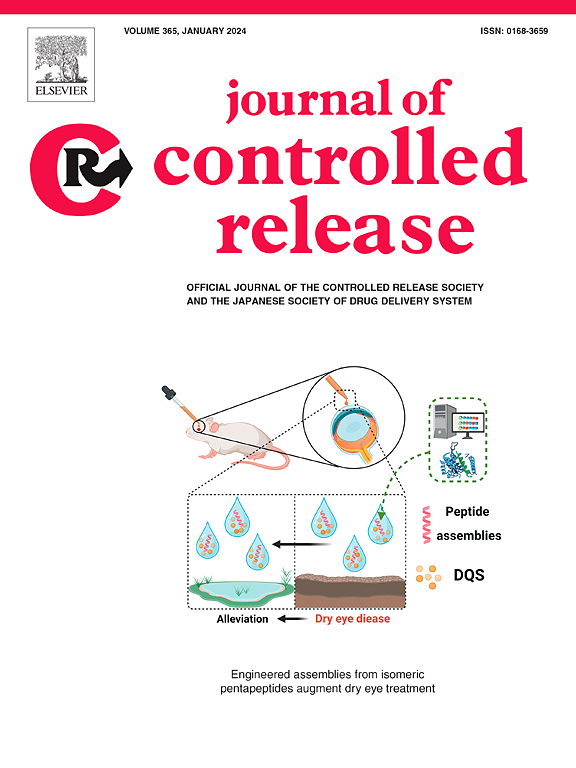Programmable chronogenetic gene circuits for self-regulated circadian delivery of biologic drugs
IF 10.5
1区 医学
Q1 CHEMISTRY, MULTIDISCIPLINARY
引用次数: 0
Abstract
Cells of the body rely on the circadian clock to orchestrate daily changes in physiology that impact both homeostatic and pathological conditions, such as the inflammatory autoimmune disease rheumatoid arthritis (RA). In RA, high levels of proinflammatory cytokines peak early in the morning hours, reflected by daily changes in joint stiffness. Chronotherapy (or circadian medicine) seeks to delivery drugs at optimal times to maximize their efficacy. However, chronotherapy remains a largely unexplored approach for disease modifying, antirheumatic treatment, particularly for cell-based therapies. In this study, we developed autonomous chronogenetic gene circuits that produce the biologic drug interleukin-1 receptor antagonist (IL-1Ra) with desired phase and amplitude. We compared expression of IL-1Ra from circuits that contained different circadian promoter elements (E'-boxes, D-boxes, or RREs) and their ability to respond to inflammatory challenges in murine pre-differentiated induced pluripotent stem cells (PDiPSC) or engineered cartilage pellets. We confirmed that each circuit reliably peaked at a distinct circadian time over multiple days. Engineered cells generated significant amounts of IL-1Ra on a circadian basis, which protected them from circadian dysregulation and inflammatory damage. These programmable chronogenetic circuits have the potential to align with an individual's circadian rhythm for optimized, self-regulated daily drug delivery.


生物药物自我调节昼夜递送的可编程时序基因电路
人体细胞依靠生物钟来协调影响体内平衡和病理状况的日常生理变化,如炎症性自身免疫性疾病类风湿性关节炎(RA)。在类风湿性关节炎中,高水平的促炎细胞因子在清晨达到峰值,这反映在关节僵硬的日常变化上。时间疗法(或昼夜医学)寻求在最佳时间给药以最大化其功效。然而,时间疗法在很大程度上仍然是一种未被探索的疾病改善、抗风湿病治疗方法,特别是基于细胞的治疗方法。在这项研究中,我们开发了自主时序基因回路,产生具有所需相位和振幅的生物药物白介素-1受体拮抗剂(IL-1Ra)。我们比较了含有不同昼夜节律启动子元件(E'-box, d -box或RREs)的回路中IL-1Ra的表达及其对小鼠预分化诱导多能干细胞(PDiPSC)或工程软骨颗粒炎症挑战的反应能力。我们证实,在数天内,每个回路都在一个不同的昼夜节律时间达到峰值。工程细胞在昼夜节律基础上产生大量的IL-1Ra,这保护它们免受昼夜节律失调和炎症损伤。这些可编程的时序电路有可能与个人的昼夜节律保持一致,以优化、自我调节每日给药。
本文章由计算机程序翻译,如有差异,请以英文原文为准。
求助全文
约1分钟内获得全文
求助全文
来源期刊

Journal of Controlled Release
医学-化学综合
CiteScore
18.50
自引率
5.60%
发文量
700
审稿时长
39 days
期刊介绍:
The Journal of Controlled Release (JCR) proudly serves as the Official Journal of the Controlled Release Society and the Japan Society of Drug Delivery System.
Dedicated to the broad field of delivery science and technology, JCR publishes high-quality research articles covering drug delivery systems and all facets of formulations. This includes the physicochemical and biological properties of drugs, design and characterization of dosage forms, release mechanisms, in vivo testing, and formulation research and development across pharmaceutical, diagnostic, agricultural, environmental, cosmetic, and food industries.
Priority is given to manuscripts that contribute to the fundamental understanding of principles or demonstrate the advantages of novel technologies in terms of safety and efficacy over current clinical standards. JCR strives to be a leading platform for advancements in delivery science and technology.
 求助内容:
求助内容: 应助结果提醒方式:
应助结果提醒方式:


